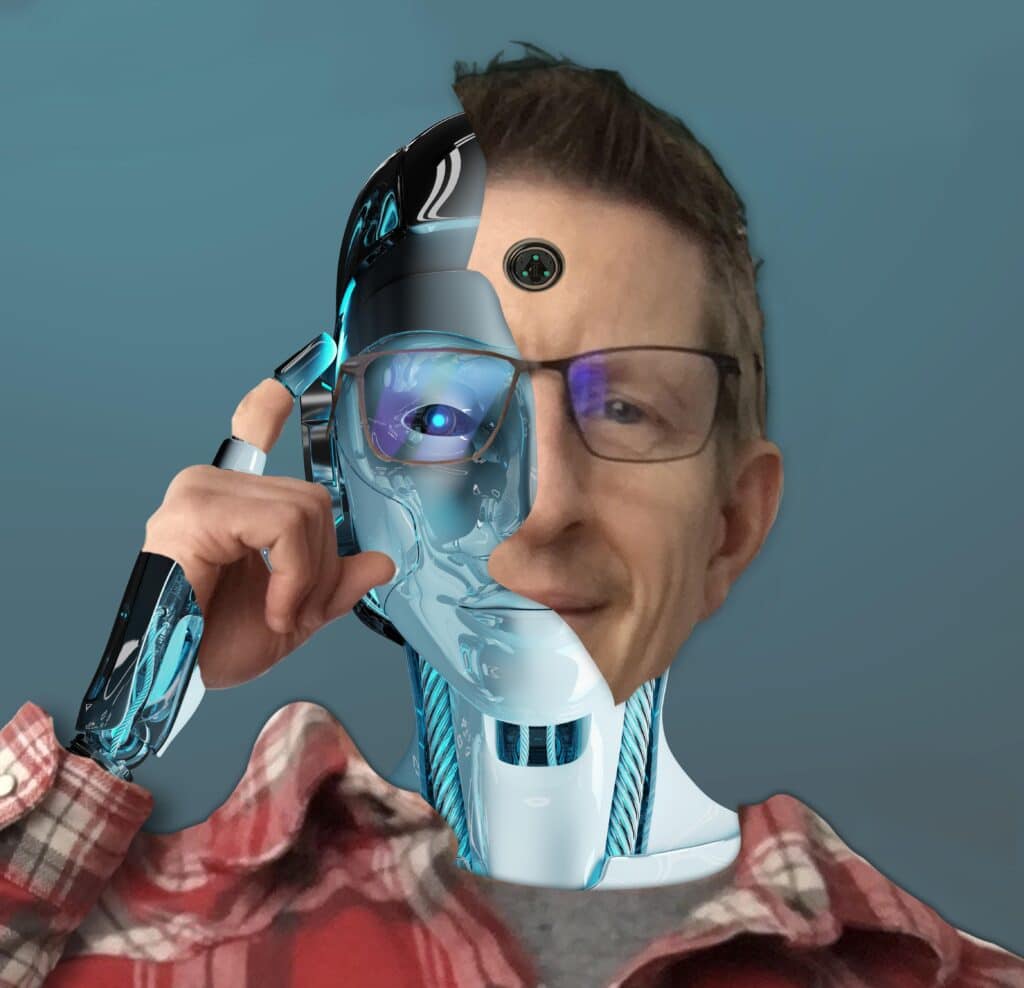• Using AI as a Tool to Save Time, Reduce Costs and Generate Custom Marketing Without Losing Your Human Connectivity
If you haven’t heard about Artificial Intelligence (AI), you’re either living on a remote island or simply not paying attention. In fact, if you’re using a chatbot on your website, you’ve already been using AI and so have your customers. But the AI I’m talking about goes beyond chatbots and their convenience, even if they don’t have the ability to show empathy like your sales team can.

(Image designed by Dana Croatt).
As I was contemplating how to write this blog on AI, in my inbox arrived a promo email from one of our MRAA Partners talking about the upcoming Digital Marketing Strategies Conference this May in Austin, Texas. Of course digital marketing is important, as nearly every one of your customers is online and shopping digitally, reading digital content and doing most of their purchasing decisions digitally prior to actually consuming in/at a brick-and-mortar location.
The thing that stuck out in the email was a bullet point highlighting some of the key topics to be discussed. The fourth bullet point read: “Using AI to reduce operational and marketing costs.” Day 2 of the conference will feature two one-hour sessions on AI, a new technology they’re calling an “era-changing evolution.” Attendees will learn about using AI for automating tasks and targeting customers. The second course digs deeper into the app ChatGPT (see sidebar), sharing its benefits and drawbacks.
That sentence is a big deal. We often joke within our marketing department about asking ChatGPT, which we use at times for interoffice fun, if it will take our marketing job. There’s validity within that question, but don’t hit the panic button yet. While your job is pretty safe for the time being, AI looks to be here for good and will only improve as more developers compete to produce products and meet the demands of AI consumers. And there should always be some sort of human involvement to AI to make it less, well, synthetic.
For the time being, it makes some sense to explore it if you have a marketing team at your business or perhaps even more so if you don’t. ChatGPT, which has set a new app growth record, according to AIbusiness.com, at 123 million users in less than three months, is currently free to use and share, but it won’t always be that way. I’ve been seeing AI blogs and content in newsletters I subscribe to quite frequently. In fact, Marcus Sheridan, who has been a subject matter expert and sales & marketing session host at Dealer Week, our annual conference & expo, has shared two separate articles on AI.
The first piece of content I saw from Marcus was in his newsletter, titled “Why Google is Freaking Out About ChatGPT, You Should Be Too.” He followed that up with another newsletter article he called “10 Ways Your Marketing Team Could Be Using ChatGPT RIGHT NOW.” He also released a video sharing tips for making your AI content more human and “Google proof.” In fact, he said, “I’m going to proactively beat this drum until many of you out there are proactively learning about and utilizing AI in your digital sales and marketing.” Finally, his company IMPACT is now offering AI training for content marketing teams. If Marcus is THIS serious about AI, you should be, too. He’s proven he has a knack for marketing and has helped many marine dealers and businesses improve.
HubSpot is all over the topic, too. One of its newsletter articles speaks on the very question we shared earlier about the technology replacing humans, but also brings up the fact that AI might replace search engines. It’s worth the read. HubSpot’s Erica Santiago wrote an article entitled “4 AI Controversies Marketers and Brands Should Avoid.” Within her blog is a link to Influencermarketinghub.com, which provides insights to its own The Ultimate Guide to AI Marketing in 2023 and says that “AI is going mainstream.” Their own summary shares that “more than 60 percent have used AI in their marketing operations” and “44 percent have adopted AI for marketing content production.”
FUTUREPEDIA, the largest AI tools directory, currently lets visitors search through 1,254 AI tools and 50 categories and segment a search with filters and types (verified, new and popular). Even the American Society of Association Executives (ASAE) along with Sidecar hosted a Webinar on AI that I attended, and also announced that more AI content will be featured at its Marketing, Membership & Communications Conference this June in Washington, D.C.
AI is definitely here to stay and will only become more significant in our lives and within business, sales and marketing as the weeks, months and year rolls on. The question is how can you use AI to improve your customer communication or marketing without losing sight of your brand, your messaging and your ability to connect as only a human can?

3 Tips for Using AI at Your Dealership
- Assign someone on your team to learn all about AI. This will typically be your marketing team or marketing manager. You do this to avoid pitfalls and discover best practices for success. They can help to evaluate the various generative AI tools and mainstream apps available to your business that will help your team the most by saving you time and energy, and making tasks simpler.
- Start small! Don’t jump in and use AI for everything, but perhaps add a chatbot to your site or try one marketing campaign using content and copy generated from ChatGPT, Jasper or another service. Don’t forget to put your team’s creative touch on it. This means you should edit the content you receive to match your voice and keep it on brand. Remember the old line, “I heard it on the Internet so it must be true”? That’s also why editing the content is important. Use your authority to enhance your message, remove any potential bias or error produced from the AI source.
- Use AI to analyze your customer data to help you find trends and patterns to improve future marketing plan activations and personalization. Be sure your best analytics employee is on the job to make sure the data important to your organization is brought out and to decipher your results. And if they then work with the marketing team, you can creatively target varying audiences and their needs, depending on your messaging and objectives to create engagement.
The goal with incorporating AI — whether it’s conversational or generative in design — into your marketing and customer touchpoints is not to replace humans. It’s to advance your team’s ability to connect and empathize with your customers. This blog simply alerts you to the rise in AI and the convenience it can provide your team, should you need it.
You shouldn’t ignore AI tools. In fact, one of the ASAE webinar speakers described the current AI popularity and transition as “going from hand tools to power tools.”
While it may be a bit too early and too costly to use every AI tool at your disposal in your dealership, it will change marketing in the near future and beyond. It also can help your team stay on task and hit your marketing deliverables with more streamlined communications. It’s up to your team to explore AI, add it to your strategic plans and use it as a supportive tool to improve your marketing both today and over the next year.
What is ChatGPT?
Did you know that ChatGPT just launched the latest version, ChatGPT-4, March 14? It’s advancing as much as it is sprouting. But what is it, exactly? I asked: “Can you tell me what ChatGPT is? It answered: “Certainly! ChatGPT is a language model developed by OpenAI. GPT stands for ‘Generative Pre-trained Transformer,’ which is a type of artificial neural network that has been trained on large amounts of text data using unsupervised learning techniques. The purpose of ChatGPT is to generate human-like responses to natural language input, making it a powerful tool for various applications such as chatbots, language translation and text summarization. ChatGPT has been trained on a diverse range of text data from the internet, including books, articles and web pages, giving it a broad knowledge base to draw from when generating responses.”




